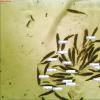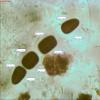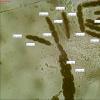
09-12-2025 12:06
 Andgelo Mombert
Andgelo Mombert
Bonjour,Je recherche l'article concernant Hypobryo

07-12-2025 16:07
Arnold BüschlenHallo, ich habe in einer Moos-Aufsammlung (epiphy

08-12-2025 21:04
Mark Stevens"Hello everyone,I'm relatively new to microscopy (

08-12-2025 18:59
 Lothar Krieglsteiner
Lothar Krieglsteiner
.. found by a seminar-participant, I do not know t

08-12-2025 17:37
 Lothar Krieglsteiner
Lothar Krieglsteiner
20.6.25, on branch of Abies infected and thickened

16-03-2014 22:00
Hello,I found this species a few months ago but ha

08-12-2025 13:39
Thomas Læssøehttps://svampe.databasen.org/observations/10572899
Sporormiella dubia
Joop van der Lee,
09-05-2013 12:48
 Found on horse dung
Found on horse dungAsci: 137.74-162.05x19.30-22.77 um
Broad on top and gradually tapering into a short stipe.
Spore: Only one mature spore collected, the rest were still too young and olive/brown in colour 49x7.87-9.11 um
Germ slits parallel
Separate cell m easurement from apex cell to basal.
12.15x7.89; 11.62-9.11; 12.92x8.67; 12.76x7.87 um
Michel Delpont,
09-05-2013 12:54

Re : Sporormiella Dubia?
hello Joop.
Il faudrait un peu plus de précisions pour pouvoir événtuellement t'aider; davantage de mesures de spores et de photos si possible bien sur.
Michel.
Il faudrait un peu plus de précisions pour pouvoir événtuellement t'aider; davantage de mesures de spores et de photos si possible bien sur.
Michel.
Joop van der Lee,
09-05-2013 13:23
Michel Delpont,
09-05-2013 14:38

Re : Sporormiella Dubia?
Indeed, if the germ slits are parallel it could be S.dubia.
Michel.
Michel.
Joop van der Lee,
09-05-2013 17:44

Re : Sporormiella Dubia?
Hello Michel,
Cain describes in Revision of the genus Spoprormia and Sporormiella the following for S. Dubia.
Asci: 8-spored, cylindircal-clavate 140-16-(-170)x16-19 um broadly rounded above, broadest near upper end, gradually tapering below into a a short stipe, measuring up to 20 um.
Asco spores bi- or tri-seriate above and uni- or bi-seriate below, 4-celled, fusiform-cylindrical, 38-45x8-9 um narrowing prominently towards the ends, olivaceaous brown when young, becoming dark brown and opaque when mature; septa transvers; constrictions at septa deep; segments easily separable; cells about equal in length; terminal cells ovoid-conical; germ slit lprominent, parallel; gelatinous sheath hyaline, moderately broad.
Cain describes in Revision of the genus Spoprormia and Sporormiella the following for S. Dubia.
Asci: 8-spored, cylindircal-clavate 140-16-(-170)x16-19 um broadly rounded above, broadest near upper end, gradually tapering below into a a short stipe, measuring up to 20 um.
Asco spores bi- or tri-seriate above and uni- or bi-seriate below, 4-celled, fusiform-cylindrical, 38-45x8-9 um narrowing prominently towards the ends, olivaceaous brown when young, becoming dark brown and opaque when mature; septa transvers; constrictions at septa deep; segments easily separable; cells about equal in length; terminal cells ovoid-conical; germ slit lprominent, parallel; gelatinous sheath hyaline, moderately broad.
Norbert Heine,
09-05-2013 22:12

Re : Sporormiella Dubia?
I also think that Sporormiella dubia is a good name for this species, Joop.
Here it's the most common species of the genus on horse dung.
Norbert
Here it's the most common species of the genus on horse dung.
Norbert
Joop van der Lee,
10-05-2013 08:52

Re : Sporormiella Dubia?
Vielen dank Norbert





